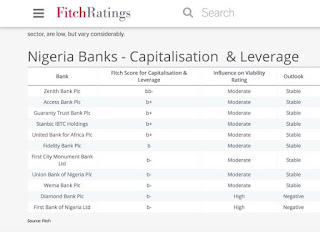Zenith , Larger Banks More Resilient Fitch Declares In Stress Test
The stress test conducted by the Central Bank of Nigeria (CBN) has
confirmed the resilience of large banks to withstand stresses over smaller
banks, even as it singled out Zenith Bank Plc for its strength in comparison to
others
Citing a Financial Stability Report for December 2016, published
recently, rating agency, Fitch, said
in its review of the regulatory test
highlighted disparities in capital strength in the Nigerian banking industry.
The apex bank’s test showed that 3 big banks failed, with their capital
adequacy ratio haven significantly fallen below the regulatory requirement.
The rating agency said in its analysis of the CBN report: “… medium and
large banks collectively could withstand a 100% increase in non-performing
loans (NPLs) but small banks (assets less than NGN500 billion) would struggle
to withstand even modest NPL deterioration.
“In our own assessment of the banks we rate, which are mostly large
(assets more than NGN1 trillion), capacity to absorb losses through capital
varies considerably.
“Zenith Bank Plc is stronger than the rest, while capital weaknesses at
First Bank National and Diamond Bank have a significant influence on their
ratings,” it added.
“All Nigerian bank ratings are in the highly speculative 'B' range, but
even so capitalisation is an important differentiator. The scores we assign,
based on capitalisation and leverage metrics across the sector, are low, but
vary considerably,” the agency explained.
The apex bank’s stress test focused on the ability of banks' capital
adequacy ratios to withstand a number of impairments arising from
Non-Performing Loans and Fitch noted in its analysis that small banks were
particularly badly hit in the stress tests.
“They already had very weak starting capital positions, with an average
capital adequacy ratio (CAR) of just 3.14% at end-2016, following sharp falls
in 2016 due to rises in NPLs. Medium and large banks had stronger starting
positions, with CARs of 12.75% and 15.47%, respectively, at end-2016,” the
agency stated.
The agency also stated: “CBN figures show that NPLs represented 14% of
total sector loans at end-2016, a very sharp increase on 5.3% at end-2015.
Unreserved NPLs represented a high 38.4% of total end-2016 regulatory capital
(end-2015: 5.9%), signaling considerable weakening in the overall capital
position of Nigeria's banking sector.
“Reported NPL ratios do not tell the whole asset quality story.
Restructuring, particularly of loans extended to the troubled upstream oil
sector, is fairly common practice in Nigeria, and restructured loans at some
rated banks account for as much as 20% of total loans,” it added.
It further noted that there was good ground to belief that that capital
buffers at banks may be weaker than reported ratios suggest.
The banks, the agency noted, remain profitable, with results boosted by
wide margins and currency revaluation gains, large in some cases.
“These are one-off gains but they have been realised and provide a
strong boost to capital, which is positive, especially in light of weak asset
quality,” it said.
The CAR is the ratio of bank’s assets to its risks. It is placed at 10
per cent for national banks and 15 per cent for banks with international
subsidiaries and 16 per cent for Systematically Important Banks (SIBs).






Comments
Post a Comment